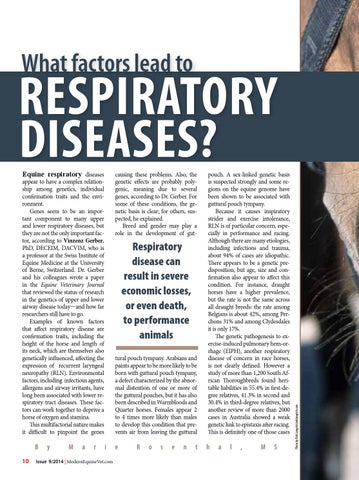What factors lead to
Equine respiratory diseases
causing these problems. Also, the genetic effects are probably polygenic, meaning due to several genes, according to Dr. Gerber. For some of these conditions, the genetic basis is clear; for others, suspected, he explained. Breed and gender may play a role in the development of gut-
appear to have a complex relationship among genetics, individual confirmation traits and the environment. Genes seem to be an important component to many upper and lower respiratory diseases, but they are not the only important factor, according to Vinzenz Gerber, PhD, DECEIM, DACVIM, who is a professor at the Swiss Institute of Equine Medicine at the University of Berne, Switzerland. Dr. Gerber and his colleagues wrote a paper in the Equine Veterinary Journal that reviewed the status of research in the genetics of upper and lower airway disease today—and how far researchers still have to go. Examples of known factors that affect respiratory disease are confirmation traits, including the height of the horse and length of its neck, which are themselves also genetically influenced, affecting the expression of recurrent laryngeal neuropathy (RLN). Environmental factors, including infectious agents, allergens and airway irritants, have long been associated with lower respiratory tract diseases. These factors can work together to deprive a horse of oxygen and stamina. This multifactorial nature makes it difficult to pinpoint the genes
B 10
y
M
a
r
tural pouch tympany. Arabians and paints appear to be more likely to be born with guttural pouch tympany, a defect characterized by the abnormal distention of one or more of the guttural pouches, but it has also been described in Warmbloods and Quarter horses. Females appear 2 to 4 times more likely than males to develop this condition that prevents air from leaving the guttural
pouch. A sex-linked genetic basis is suspected strongly and some regions on the equine genome have been shown to be associated with guttural pouch tympany. Because it causes inspiratory strider and exercise intolerance, RLN is of particular concern, especially in performance and racing. Although there are many etiologies, including infections and trauma, about 94% of cases are idiopathic. There appears to be a genetic predisposition, but age, size and confirmation also appear to affect this condition. For instance, draught horses have a higher prevalence, but the rate is not the same across all draught breeds: the rate among Belgians is about 42%, among Perchons 31% and among Clydesdales it is only 17%. The genetic pathogenesis to exercise-induced pulmonary hem-orrhage (EIPH), another respiratory disease of concern in race horses, is not clearly defined. However a study of more than 1,200 South African Thoroughbreds found heritable liabilities in 55.4% in first-degree relatives, 41.3% in second and 30.4% in third-degree relatives, but another review of more than 2000 cases in Australia showed a weak genetic link to epistaxis after racing. This is definitely one of those cases
e
h
Respiratory disease can result in severe economic losses, or even death, to performance animals
i
Issue 9/2014 | ModernEquineVet.com
R
o
s
e
n
t
a
l
,
M
S
Photo by Bob Langrish boblangrish.com
respiratory diseases?
